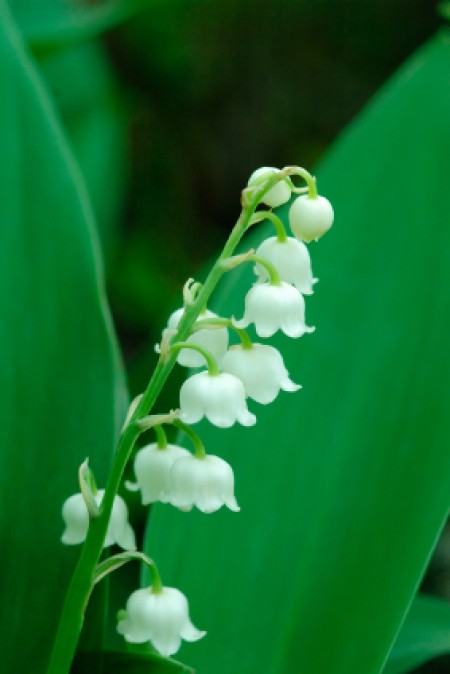
Three words that describe lily-of the-valley are beautiful, reliable, and fragrant. Its delightful sweet smelling, spring flowers are reason enough to grow them, but lily-of the-valley also offers reliable solutions to problem areas of the garden.
Hardiness: Zones 2-7
Life cycle: Perennial
Height: 8-10 inches
Spread: Individual plants are small, but if not contained, they may quickly become invasive and spread through the garden.
Flowers: Clusters of small, bell-shaped blooms on narrow, arching flower stalks, white or pink in color, and blooms in spring to early summer.
Cut flowers for bouquets when bells are fully developed. The flowers usually last just over a week. Spring flowers are followed by attractive glossy orange berries.
Foliage: Large, lance-shaped leaves of a deep glossy green.
Light needs: Partial to full shade, but will tolerate full sun in cooler climates.
Soil type: Prefers moist, well-drained soil; adaptable to less favorable conditions.
Warning: ALL parts of this plant are poisonous if ingested.
When introducing lily-of the-valley to your garden, seeding isn't recommended because it takes too long for plants to reach maturity. Instead, you will be planting "pips", small growth buds from the lily's underground rhizomes. They take only 1 to 2 years to produce flowers.
Pips can be found at local nurseries or through mail order companies. The best time to plant them is in the early spring. Container grown plants are also available, which can be planted anytime during the growing season. Lily-of the-valley looks best when planted in masses. Pips should be planted about 1 inch deep, and spaced 3 to 4 inches apart.
Most gardeners are familiar with the common green-leaved, white-flowered variety lily of the valley, but there are other varieties available as well. There is the pale pink-flowered 'Rosea', which is less fragrant; also the dapple-leaved 'Variegata', the white-striped 'Albostriata', the 'Aureovariegata' with yellow striped leaves, or Fortin's Giant, a taller variety that grows to a height of 12 inches.
Lily-of the-valley combines well with other plants. Use it around the base of azaleas, rhododendrons, monkshood, or in combination with snow-in-summer and rockcress. It also pairs nicely with periwinkle and spring bulbs like daffodils.
Lily of the valley is one of the few plants that thrive in the deep shade of mature trees. It provides a dense carpet of green leaves that remain attractive until fall frosts. In cooler climates, it will also grow well in full sun. The plants prefer moist, well-drained soil. They will readily adapt to dry conditions, although the plants may be paler in color, and produce less flowers. This makes them wonderfully versatile for filling in those trouble spots in the garden where other plants refuse to grow.
Keeping lily-of the-valley contained: If your intentions is to use lily of the valley as a ground cover (e.g. on a steep slope), it can be allowed to spread indefinitely. However, because it spreads so rapidly, it can quickly become a pest when grown in the flower bed. Use edging, stones, or other barriers to contain its spread. Lily-of-the-valley has also been known to become invasive in forest settings, and should not be planted and allowed to grow unchecked near wooded areas.
Caring for lily-of-the-valley couldn't be easier. Give plants growing under mature trees and shrubs a dose of slow release organic fertilizer each Spring. Otherwise, water plants periodically, and apply 1 to 2 inches of mulch at the base to help conserve water. In the spring, tidy up plants by removing last year's foliage. If leaf spot or stem rot occasionally cause problems, simply remove infected plant parts and destroy them. After a few years, lilies-of-the-valley growing in garden beds may start to become overcrowded. Dividing plants every few years will give them some breathing room and encourage the production of more flowers.

About The Author: Ellen Brown is an environmental writer and photographer and the owner of Sustainable Media, an environmental media company that specializes in helping businesses and organizations promote eco-friendly products and services. Contact her on the web at http://www.sustainable-media.com
Add your voice! Click below to comment. ThriftyFun is powered by your wisdom!
Thank you for bringing back childhood memories. Coming home from grade school I'd always pick Lily of the Valley and Lilacs to bring home for my Mom. Next Spring, for sure, I'll plant some.
These would be great in my garden. I am going to plant them. They sound beautiful! I am not worried about their invasiveness, that is actually a good point for me.
Hello,
Just 2 things I would like to add : if you want to use Lily of the Valley as ground cover, keep in mind that it will always try to go north so it has to be planted in a southern part preferably in the shade. Keep also in mind that it is toxic. All the parts of the plant are toxic even the water of the vase where you put it is toxic but it is beautiful indeed.
It is very pretty and it's fun to pick a bouquet and place in water with a bit of food coloring. The color enters the flowers and creates striping. But I doubt I will ever plant it again because it's so much work to contain.
Add your voice! Click below to comment. ThriftyFun is powered by your wisdom!